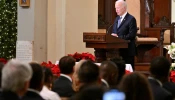Q. 869. What does the word Eucharist strictly mean?
A. The word Eucharist strictly means pleasing, and this Sacrament is so called because it renders us most pleasing
to God by the grace it imparts, and it gives us the best means of thanking Him for all His blessings.
Q. 870. What is the Holy Eucharist?
A. The Holy Eucharist is the Sacrament which contains the body and blood, soul and divinity, of our Lord Jesus
Christ under the appearances of bread and wine.
Q. 871. What do we mean when we say the Sacrament which contains the Body and Blood?
A. When we say the Sacrament which contains the Body and Blood, we mean the Sacrament which is the Body
and Blood, for after the Consecration there is no other substance present in the Eucharist.
Q. 872. When is the Holy Eucharist a Sacrament, and when is it a sacrifice?
A. The Holy Eucharist is a Sacrament when we receive it in Holy Communion and when it remains in the
Tabernacle of the Altar. It is a sacrifice when it is offered up at Mass by the separate Consecration of the bread
and wine, which signifies the separation of Our Lord's blood from His body when He died on the Cross.
Q. 873. When did Christ institute the Holy Eucharist?
A. Christ instituted the Holy Eucharist at the Last Supper, the night before He died.
Q. 874. Who were present when our Lord instituted the Holy Eucharist?
A. When Our Lord instituted the Holy Eucharist, the twelve Apostles were present.
Q. 875. How did our Lord institute the Holy Eucharist?
A. Our Lord instituted the Holy Eucharist by taking bread, blessing, breaking, and giving to His Apostles, saying:
"Take ye and eat. This is my body"; and then, by taking the cup of wine, blessing and giving it, saying to them:
"Drink ye all of this. This is my blood which shall be shed for the remission of sins. Do this for a commemoration of me."
Q. 876. What happened when our Lord said, "This is my body; this is my blood"?
A. When Our Lord said, "This is my body," the substance of the bread was changed into the substance of His
body; when He said, "This is my blood," the substance of the wine was changed into the substance of His blood.
Q. 877. How do we prove the Real Presence, that is, that Our Lord is really and truly present in the Holy Eucharist?
A. We prove the Real Presence -- that is, that Our Lord is really and truly present in the Holy Eucharist:
1.By showing that it is possible to change one substance into another;
2. By showing that Christ did change the substance of bread and wine into the substance of His body and
blood;
3. By showing that He gave this power also to His Apostles and to the priests of His Church.
Q. 878. How do we know that it is possible to change one substance into another?
A. We know that it is possible to change one substance into another, because:
1.God changed water into blood during the plagues of Egypt.
2. Christ changed water into wine at the marriage of Cana.
3.Our own food is daily changed into the substance of our flesh and blood; and what God does gradually,
He can also do instantly by an act of His will.
Q. 879. Are these changes exactly the same as the changes that take place in the Holy Eucharist?
A. These changes are not exactly the same as the changes that take place in the Holy Eucharist, for in these
changes the appearance also is changed, but in the Holy Eucharist only the substance is changed while the
appearance remains the same.
Q. 880. How do we show that Christ did change bread and wine into the substance of His body and blood?
A. We show that Christ did change bread and wine into the substance of His body and blood:
1. From the words by which He promised the Holy Eucharist;
2. From the words by which He instituted the Holy Eucharist;
3. From the constant use of the Holy Eucharist in the Church since the time of the Apostles;
4. From the impossibility of denying the Real Presence in the Holy Eucharist, without likewise denying all
that Christ has taught and done; for we have stronger proofs for the Holy Eucharist than for any other
Christian truth.
Q. 881. Is Jesus Christ whole and entire both under the form of bread and under the form of wine?
A. Jesus Christ is whole and entire both under the form of bread and under the form of wine.
Q. 882. How do we know that under the appearance of bread we receive also Christ's blood; and under
the appearance of wine we receive also Christ's body?
A. We know that under the appearance of bread we receive also Christ's blood, and under the appearance of
wine we receive also Christ's body; because in the Holy Eucharist we receive the living body of Our Lord, and a
living body cannot exist without blood, nor can living blood exist without a body.
Q. 883. Is Jesus Christ present whole and entire in the smallest portion of the Holy Eucharist, under the
form of either bread or wine?
A. Jesus Christ is present whole and entire in the smallest portion of the Holy Eucharist under the form of either
bread or wine; for His body in the Eucharist is in a glorified state, and as it partakes of the character of a spiritual
substance, it requires no definite size or shape.
Q. 884. Did anything remain of the bread and wine after their substance had been changed into the
substance of the body and blood of our Lord?
A. After the substance of the bread and wine had been changed into the substance of the body and blood of Our
Lord, there remained only the appearances of bread and wine.
Q. 885. What do you mean by the appearances of bread and wine?
A. By the appearances of bread and wine I mean the figure, the color, the taste, and whatever appears to the
senses.
Q. 886. What is this change of the bread and wine into the body and blood of our Lord called?
A. This change of the bread and wine into the body and blood of Our Lord is called Transubstantiation.
Q. 887. What is the second great miracle in the Holy Eucharist?
A. The second great miracle in the Holy Eucharist is the multiplication of the presence of Our Lord's body in so
many places at the same time, while the body itself is not multiplied -- for there is but one body of Christ.
Q. 888. Are there not, then, as many bodies of Christ as there are tabernacles in the world, or as there
are Masses being said at the same time?
A. There are not as many bodies of Christ as there are tabernacles in the world, or as there are Masses being said
at
the same time; but only one body of Christ, which is everywhere present
whole and entire in the Holy Eucharist, as God is everywhere present,
while He is but one God.
Q. 889. How was the substance of the bread and wine changed into the substance of the body and blood of Christ?
A. The substance of the bread and wine was changed into the substance of the body and blood of Christ by His
almighty power.
Q. 890. Does this change of bread and wine into the body and blood of Christ continue to be made in the
Church?
A. This change of bread and wine into the body and blood of Christ continues to be made in the Church by Jesus
Christ through the ministry of His priests.
Q. 891. When did Christ give His priests the power to change bread and wine into His body and blood?
A. Christ gave His priests the power to change bread and wine into His body and blood when He said to the
Apostles, "Do this in commemoration of Me."
Q. 892. What do the words "Do this in commemoration of Me" mean?
A. The words "Do this in commemoration of Me" mean: Do what I, Christ, am doing at My last supper, namely,
changing the substance of bread and wine into the substance of My body and blood; and do it in remembrance of
Me.
Q. 893. How do the priests exercise this power of changing bread and wine into the body and blood of
Christ?
A. The priests exercise this power of changing bread and wine into the body and blood of Christ through the
words of consecration in the Mass, which are words of Christ: "This is my body; this is my blood."
Q. 894. At what part of the Mass does the Consecration take place?
A. The Consecration in the Mass takes place immediately before the elevation of the Host and Chalice, which are
raised above the head of the priest that the people may adore Our Lord who has just come to the altar at the
words of Consecration.











